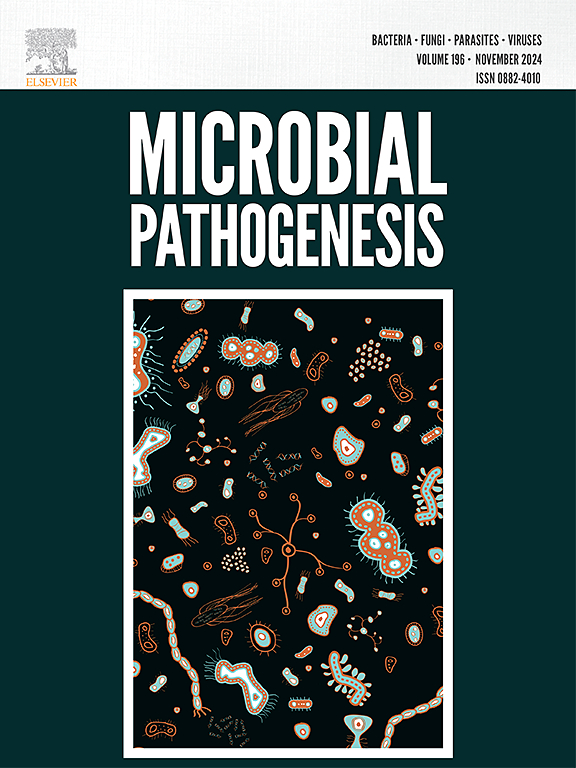ESBL-producing Klebsiella Pneumoniae isolated from dairy cows with pneumonia: insight into their epidemiology, genetic features and antimicrobial resistance profiles
IF 3.5
3区 医学
Q3 IMMUNOLOGY
引用次数: 0
Abstract
Klebsiella pneumoniae is a common cause of respiratory tract infections in humans and animals. This study surveyed the epidemiology and analyzed the genetic and resistance characteristics, and the pathogenicity of 37 K. pneumoniae from 316 dairy cows with pneumonia in Hebei Province (north China). To clarify the relationship between the isolates, antimicrobial susceptibility testing, PCR, high viscosity, extracellular polysaccharide content, biofilm formation and mouse infection model were used to decipher the relationship between different phenotypes of strains and drug resistance and virulence. Whole-genome sequencing was used to analyze and characterize the genetic features of some strains. Clinical treatment with medication based on drug susceptibility results. According to the results of Vitek 2 compact and the broth microdilution test, there were 81.0 % (30/37) ESBL-producing K. pneumoniae with a higher multiple antibiotic resistance (MAR) index. The isolates were mainly resistant to β-lactam and aminoglycoside antibiotics. The most frequently identified beta-lactamase genes were blaSHV, blaCTX-M, and blaTEM, aph(3″)-Ib, aph(6)-Id, and aph(3′)-Ia. IncFII(K), IncQ1, IncFIB(K), and repB (R1701) were the main resistant plasmid replicons identified and multiple-replicon plasmids often carried more drug resistance genes. The major clone was ST43. The phylogenetic analysis presented the genetic diversity and close phylogenetic relationship between strains from humans, economic animals, and the environment. Moreover, using a mouse infection model, this study demonstrated that isolates with certain virulence profiles and significant resistance characteristics exhibited higher infection levels. Clinical data analysis suggested that co-medication had a positive effect on the outcome of the treatment. This work indicated that strengthening the clinical attention and epidemiological monitoring of multidrug-resistant ESBL-producing isolates from different sources is necessary and urgent. This work indicated that it is urgent and necessary to enhance the clinical vigilance and epidemiological monitoring of multidrug-resistant ESBL-producing K. pneumoniae.
从患有肺炎的奶牛中分离出产esbl的肺炎克雷伯菌:对其流行病学、遗传特征和抗菌素耐药性概况的深入了解
肺炎克雷伯菌是人类和动物呼吸道感染的常见病因。本研究调查了河北省316头奶牛肺炎病例中37种肺炎克雷伯菌的流行病学,分析了其遗传、耐药特征及致病性。为了明确分离株之间的关系,我们采用了药敏试验、PCR、高黏度、胞外多糖含量、生物膜形成和小鼠感染模型来解读菌株不同表型与耐药和毒力的关系。采用全基因组测序对部分菌株的遗传特征进行了分析和表征。临床根据药敏结果进行用药治疗。根据Vitek 2 compact和肉汤微量稀释试验结果,产esbl肺炎克雷伯菌占81.0%(30/37),且多重抗生素耐药指数较高。菌株主要对β-内酰胺类和氨基糖苷类抗生素耐药。最常见的β -内酰胺酶基因为blaSHV、blaCTX-M、blaTEM、aph(3′)-Ib、aph(6′)-Id、aph(3′)-Ia。IncFII(K)、IncQ1、IncFIB(K)和repB (R1701)是鉴定出的主要耐药质粒复制子,多复制子质粒往往携带较多耐药基因。主要的克隆是ST43。系统发育分析表明,来自人类、经济动物和环境的菌株具有遗传多样性和密切的系统发育关系。此外,通过小鼠感染模型,本研究表明具有一定毒力特征和显著抗性特征的分离株具有较高的感染水平。临床资料分析表明,联合用药对治疗结果有积极影响。结果表明,加强对不同来源的产esbl多药菌株的临床关注和流行病学监测是必要和迫切的。提示加强对产esbl多药肺炎克雷伯菌的临床警惕和流行病学监测十分迫切和必要。
本文章由计算机程序翻译,如有差异,请以英文原文为准。
求助全文
约1分钟内获得全文
求助全文
来源期刊

Microbial pathogenesis
医学-免疫学
CiteScore
7.40
自引率
2.60%
发文量
472
审稿时长
56 days
期刊介绍:
Microbial Pathogenesis publishes original contributions and reviews about the molecular and cellular mechanisms of infectious diseases. It covers microbiology, host-pathogen interaction and immunology related to infectious agents, including bacteria, fungi, viruses and protozoa. It also accepts papers in the field of clinical microbiology, with the exception of case reports.
Research Areas Include:
-Pathogenesis
-Virulence factors
-Host susceptibility or resistance
-Immune mechanisms
-Identification, cloning and sequencing of relevant genes
-Genetic studies
-Viruses, prokaryotic organisms and protozoa
-Microbiota
-Systems biology related to infectious diseases
-Targets for vaccine design (pre-clinical studies)
 求助内容:
求助内容: 应助结果提醒方式:
应助结果提醒方式:


